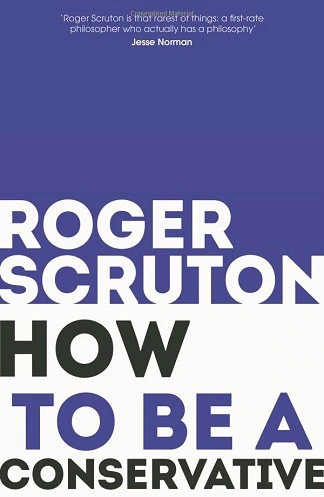| Title | How to be a Conservative |
| Author | Ruger Scruton |
| Publisher | Bloomsbury Continuum |
| Year | 2019 |
| Pages | 208 |
| Rating | ★★★★★ |
| Purchase Link | Buy Here |
The book “How to be a Conservative”, written by British philosopher Roger Scruton, challenges the traditional understanding of conservatism and explores its relevance in contemporary society.
This article seeks to analyze the work in detail, highlighting the author’s approach, the book’s content, its main lessons, positive and negative points, and finally, to examine whether it is worth reading. You can read many other book summaries here.
Synopsis of How to be a Conservative
“How to be a Conservative” is an important work that offers a deep insight into conservative thought, an often misunderstood ideology.
Scruton explores the origins and principles of conservatism, arguing that it is not just a reaction to change, but a philosophy that values the past and tradition. For Scruton, conservatism is a posture that aims to preserve and transmit the cultural and moral legacy we have received, and it is a response to hasty and thoughtless change.
The book examines conservatism in various areas of modern life, including politics, religion, art, and education. You can buy How to be a Conservative clicking here.
Who was Roger Scruton?
Scruton has written more than 50 books on morality, culture, art, politics and religion, gaining worldwide recognition for his profound and provocative reflections.
Roger Scruton was a prominent British philosopher, writer and public commentator, best known for his views and work in the field of political and aesthetic philosophy. He was professor of philosophy at the University of London and Oxford and was one of the most influential conservative thinkers of his generation.
“How to be a Conservative” is one of his most notable works, in which he explores and defends conservatism as a viable and necessary political philosophy. You can read a summary about his other book “Conservatism: an Invitation to the Great Tradition”.
Summary of How to be a Conservative
In the book, Scruton argues that society must change and evolve, but in ways that preserve and respect the past.
The book is divided into several sections that explore different aspects of conservatism. Scruton examines ideology in relation to politics, art, education, the environment, religion, nationality, and gender. In each section, he argues for conservatism, explaining how this approach can balance necessary changes with preserving important values.
In “How to be a Conservative”, Scruton argues that conservatism is not a blind resistance to change, but a thoughtful approach that values tradition and cultural heritage. You can buy How to be a Conservative clicking here.
Review of How to be a Conservative
“How to be a Conservative” is a profound and challenging read that forces the reader to reflect on their own beliefs and prejudices.
Scruton writes clearly and convincingly, making his ideas accessible even to those unfamiliar with conservatism. The book is more than a defense of conservatism; it is a call to balance and reflection. Scruton argues that change is necessary, but it must be thoughtful and respectful of the past. It’s worth reading!
He believes that conservatism offers this balance, providing an approach that values tradition while recognizing the need for evolution. You can buy How to be a Conservative clicking here.
9 Key Lessons from How to be a Conservative
See a little about this famous book by the English conservator.
1. Conservatism is not a resistance to change, but an approach that values tradition.
2. Society must evolve, but in a way that preserves and respects the past.
3. Conservatism is relevant in all areas of modern life, including politics, art, education and religion.
4. Change must be thoughtful and respectful of the past.
5. Conservatism strikes a balance between preservation and progress.
6. Conservatism is about passing on cultural and moral legacy.
7. Conservatism is a viable and necessary political philosophy.
8. Conservatism is a response to hasty and thoughtless change.
9. Change is necessary, but it must be done with respect for tradition.
Negatives Points of How to be a Conservative
While “How to be a Conservative” is a brilliant work, it also has its limitations.
The book can be a little dense and academic for some readers, making some sections difficult to follow. Furthermore, as Scruton is clearly in favor of conservatism, his approach may be seen as biased by some readers.
But that doesn’t stop the book from being fruitful and not worth reading. On the contrary, it is an excellent read! Read a summary about Mere Christianity (C. S. Lewis) here.
Positives Points of Being Conservative
Scruton’s work is a profound and well-reasoned exploration of conservatism, presented in a clear and accessible way.
He challenges common preconceptions about ideology and offers a much-needed new perspective. The book is exceptionally well written and argued, with Scruton explaining his ideas clearly and convincingly. The book is also notable for its comprehensiveness.
Scruton explores conservatism in many different areas of modern life, showing how the philosophy can be practically and meaningfully applied.
This makes the book relevant to a wide range of readers. Read a summary about his other book ‘Fools, Frauds and Firebrands’ here.
Is it worth reading How to be a Conservative?
“How to Be a Conservative” is undoubtedly a valuable read for anyone interested in politics, philosophy, or history.
Even for those who don’t identify as conservative, the book offers a valuable understanding of an ideology that plays a significant role in politics and global society. Scruton’s perspective is undeniably valuable, offering a deep reflection on the relationship between tradition, change and society. It is worth it!
Scruton offers a rich and complex view of conservatism, challenging preconceived notions and inviting the reader to reflect on their own beliefs.
In short, “How to Be a Conservative” is essential reading for anyone who wants to better understand conservatism and its place in the modern world. You can buy How to be a Conservative clicking here.
Questions about How to be a Conservative
See some questions about this book on conservatism.
What does it mean to be a conservative person?
Being conservative means valuing and defending traditions, established family and social values, and being resistant to rapid and radical changes in society.
What does it mean to be conservative in Brazil?
In Brazil, being conservative is supporting traditional values such as the nuclear family, religion, private property, and opposing rapid change, especially on social and moral issues.
What are conservative values?
Conservative values include respect for tradition, social order, private property, the nuclear family, and religion. It can also include skepticism of rapid social change.
What is a conservative society?
A conservative society is one that values established cultural, moral and social traditions, resisting rapid change and promoting social continuity.
What is a conservative and liberal person?
A conservative and liberal person values social traditions (conservatism), but also defends individual and economic freedom (liberalism).
What does it mean to be a right person?
Being on the right generally implies supporting the market economy, private property, limiting the state’s role in the economy, and traditional values.
What does it mean to be a leftist?
Being on the left generally implies supporting social equality, state intervention in the economy, and progressive changes in society.
What is the difference between traditional and conservative?
Traditional refers to adherence to ancient customs and practices, while conservative is resisting rapid change while maintaining established values and institutions.
Who did the conservatives represent?
Conservatives generally represent those who value traditions, social order, private property, and are resistant to rapid changes in society.
What is a conservative approach?
A conservative approach is cautious, resisting rapid change while preserving established traditions and values.
Who are the right-wing Philosophers?
Friedrich Hayek, Roger Scruton and Thomas Sowell are examples of right-wing philosophers.
What is the difference between left and right?
The left generally supports social equality and state intervention in the economy, while the right values a market economy, private property and traditional values.
What is it like to be a communist?
To be a communist is to believe in the political theory that defends the elimination of private property and total socioeconomic equality, as proposed by Karl Marx and Friedrich Engels.
What does it mean to be extreme right?
Being far-right often involves strongly nationalist, anti-immigration, anti-globalization positions, and often support for a strict traditional social and cultural order.
What does the Bible say about left and right?
The Bible does not refer to left and right in a political sense. In some passages, “right” is associated with divine favor, while “left” has no specific connotation.
What’s the difference between the Conservative Party?
This question is not clear. Conservative parties vary from country to country, with differences based on local conditions and political priorities.
What does it mean to be a traditional person?
Being a traditional person implies adhering to established customs and practices, valuing social and cultural continuity over rapid change or innovation.
What is conservative modernization?
Conservative modernization is a process that aims to update institutions and practices without significantly altering existing traditional values and structures.
What does the far left stand for?
The far left advocates massive state intervention in the economy, radical social equality, and can support revolution to change the existing social order.
What is the difference between left-right and center in politics?
The left defends social equality and state intervention in the economy, the right defends the free market and traditional values, and the center seeks a balance between these extremes.
What are conservative countries?
Countries such as the United States, Saudi Arabia, Iran and Russia are often considered conservative due to their adherence to social, religious and political traditions.
What did conservatives stand for?
This question is a broad one, but in general, conservatives defend traditions, private property, and are resistant to rapid changes in society.
Who is the father of conservatism?
Edmund Burke is often considered the “father of conservatism” due to his defense of traditions and the established social order.
What did the moderates stand for?
Moderates generally advocate a balance between social progress and maintaining the existing order, seeking compromises and avoiding political extremes.

